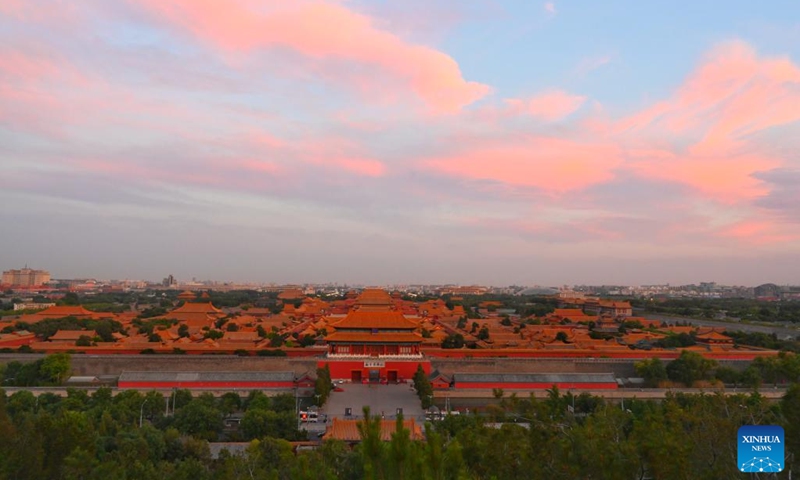
This photo taken on June 7, 2023 shows the view of sunset glow over the Palace Museum in Beijing, capital of China.(Photo: Xinhua)
Soaked for two straight days, Beijing’s faced its first heavy downpour of the rain season, which lasted until Saturday, casting a shadow on the summer heat in the capital. The downpour didn’t hinder the operations of the Palace Museum, whose hundred-years-old drainage system kept the crammed architectural complex functioning as normal.
According to the Beijing Meteorological Service on Saturday, the heavy rainfall of 50.4mm/hour drenched large part of Beijing, including thePalace Museum, on Saturday morning and the very rare scene of “1,000 dragon heads spouting water” left an impressive memory for thousands of visitors to come.
The videos of the scene went viral on Chinese social media Sina Weibo, showing the dragon heads spitting water and the “water-proof” flat floor.
The drainage system inside the Palace Museum is a topic of interest among all visitors and history lovers.
“There are 1,142 dragon-head drain spouts. We are very lucky to enjoy this phenomenon even though we have to do that in this heavy rain,” Guan Ping, a Beijing-based historian who happened to be visiting the Museum with his niece on Saturday, told the Global Times.
Being an important part of the cultural relics of the Palace Museum, the drainage system is under protection like other ancient architectural elements. During the 18 years of renovation from 2002 to 2020, the drainage system was part of the renovation plan, but compared with the most original ones, the adjustments made by the restorers have not changed much, Guan noted.
The Palace Museum divides the drainage system into several areas, and carries out a cleaning of the drainage system every 4 to 5 years, as former curator Shan Jixiang explained to Xinhua News Agency.
“The construction of the drainage system is a perfect combination of the practicality and aesthetics of ancient China,” added Guan, who had just finished his tour in the heavy rain with his family.
There was no accumulation of rain for about 600 years in the Palace Museum as the ancient craftsmen have considered the drainage issues when they built it, said the experts.
The design of all types of roofs of palaces in the Palace Museum follows the characteristics of high ridges and steep slopes to rapidly drain rainwater, from the official WeChat account of the Palace Museum.
Most of the buildings in the Palace Museum are on high platforms, with the highest reaching about eight meters above the ground, so that the rain water could flow down naturally.
Two inner drainage amenities play an important role in the Palace Museum: the visible and invisible drainage systems. The visible systems are the drainage outlets and drainage nozzles, these can discharge the water inside the Palace Museum into the moat outside, allowing this rain water to circulate efficiently around the Palace Museum.
Additionally, the invisible drainage system consists of the drainage pipes buried underneath the black brick, after a rainstorm, the rain water can penetrate into these internal pipes and be discharged outside of the Palace Museum.
“All the countertops in the Palace Museum consistently slope slightly outward. Additionally this drainage channel is not only from the ground down, it is also buried in the corresponding culvert, in order to better solve the drainage problem,” said Ma Jiannong, a vice president of the Beijing Historical Research Society.
The Palace Museum combines drainage with architectural aesthetics, this reflects the ancient people’s attention to the practical and aesthetic integration of architectural design concepts, Ma said.
URL: https://www.seeglobalnews.com/read-1942.html